This is going to be a long one, sorry! But in order to get the point across, this post required lots of pictures and I didn't have anyone nearby to video a tutorial, so sit back and enjoy, if possible! If you've been following me on Instagram, you've seen some pictures of my postage stamp quilt with quilted cables in the borders. This has raised several questions as to how I do this. Most people thought this was done with free-motion quilting, but IT IS NOT! This is all done with a walking foot, it's do-able for the beginner, you can do this on your home sewing machine with the proper accessories, and the results are worth the extra effort.
I strive for a pretty traditional look in my quilts and in my quilting. I really love the LOOK of hand-quilted quilts, particularly antique Amish quilts. When I started quilting way back when, I tried hand-quilting ONCE, and that was enough! But I didn't want to quilt my quilts just any ole way, I wanted them to have a "finished" look, almost like they are antiques themselves. So I did a lot of straight line quilting, read several machine quilting books that were out at the time, and really studied antique quilts and how they were quilted.
Cables in borders appeared again and again. After thinking about it, I thought it couldn't be that difficult to do with a walking foot, it's basically a continuous line with gentle curves. And I still had not jumped into free-motion quilting at this point, I was never happy with my results and was too impatient to practice or sacrifice a quilt top. But after my first quilt that I quilted cables in the border, I was hooked. It looked almost hand-quilted and I loved the look. And best of all, it was easy to do.
So to make this easy to understand, I tried to photograph the process I go through while I quilted Forty-Nine Cents. I do mark all of my lines I intend to quilt with a water soluble blue marker. I've been using these markers for over 20 years and never had issues with them not coming out. I also WASH all of my quilts as soon as they are quilted, so this gives me peace of mind that I know the marker doesn't have enough time to set in the fabric and become permanent. And I quilt a top as soon as I mark it, I don't let it sit around for weeks or months.
Basting is also critical and I do pin-baste. Every one has a variation on the technique, but my method is based on Harriet Hargrave's method in her book, Heirloom Machine Quilting. I use an old folding table, clamp the backing fabric to it first, then lay the batting over it and then the top. I am very careful to keep everything smooth and pin fairly close together. When I finish basting, I check my backing for pleats or puckers. Now is the time to correct them and repin if necessary! Otherwise they will just get quilted in permanently later.
I mostly do some variation of grid quilting, channel quilting, or other combination of straight lines in the main body of the quilt. The above pictures show how I package the quilt to feed it into the machine. The walking foot does most of the work but I do support the front so that it doesn't drag on the needle. This part is just a matter of sewing along the lines. I remove the surrounding pins as I go and after each line is sewn.
In this photo above, I am done quilting the lines in the center of the quilt and am ready to start on the borders. This quilt has an inner border with a smaller, tighter cable, a pieced border with straight line channel quilting, and an outer border with a larger, gently curved cable. I approach everything from the center, working out to the edge, or from left to right. For a beginner, until you have done several quilts with cables, I would suggest only doing them on the outer most border at first until you get the hang of it.
Every brand of sewing machine is different, so talk to your dealer about what will work for you regarding a walking foot and a single hole throat plate. It can be an investment, but if this is something that you think you will do, it's worth the money spent.
I set my ironing board directly to the left of where I am sitting. At this stage, the quilt isn't packaged like it was when I was sewing the straight lines. The ironing board helps support the excess to the left and gives me a larger flat surface so the quilt doesn't hang down the front of my counter.
The cables on this quilt happen to wrap around the corners. Sometimes I use cables that run off the edge of the quilt, it just depends. But in this case, I want to start in a seamline so that my starts and stops are hidden. Here I am pulling up the bobbin thread to the top of the quilt.
Once I pull both the top and bobbin threads off to the side, I put the needle in the DOWN position right in that seamline. The needle must stay in the down position throughout because this does require raising and lowering the presser foot.
Since I needed two hands to photograph, I placed my Machingers quilting gloves on the quilt so you can get an idea of where I position my hands. Please note that BEFORE I start sewing on this line, I removed the first safety pin! I usually keep pins in until I am actually sewing in the immediate area.
Here is another shot that shows an overall view of where my hands are in relation to the rest of the quilt. Keep in mind, this is fairly slow sewing, very unlike free-motion. I am using my hands almost like I would if I was free-motion quilting, palms flat, and guiding the quilt under the needle, following the line. On a tighter cable such as this one in the innermost border, it required me to raise and lower the presser foot fairly often to get around the curves. If you have ever machine-appliqued around circles or shapes, it's the same idea. The larger cables allow for a little more speed, but for me, it's not about how fast I can quilt, it's about the finished look in the end.
The other thing that takes a little time is you will constantly have to arrange, rearrange, and adjust the position of the rest of the body of the quilt, especially when you are sewing a cable that wraps around the four borders. You are sewing one cable line at a time, all the way around the four sides each time.
Here I have ended the first line of quilting. I left enough thread to triple knot both pairs, the beginning threads and the ending threads, and then threaded each pair onto a crewel needle, one pair at a time, and buried the threads in between the layers. I bury the threads at the end of each line of stitching as I progress, it makes it much easier than doing them all at once when you are finished.
These pictures show how I am progressing to each line, one at a time, working from left to right.
And here I have completed all the quilting! At this point I am so happy to be done, I can't wait to get it trimmed, squared, and in the wash next.
After trimming off the excess from the edges of the quilt, I run the edge of the entire quilt through a serger (overlock machine). You could also do a zigzag or similar stitch. YES, I do wash my quilt BEFORE I put the binding on. And of course, I don't want the edges to ravel and fray in the wash. Plus this gives me a nice flat edge for binding. The main reason I wash it first before binding is that I want the quilt and batting to shrink and do all its puckering beforehand. Afterwards, I put on the hanging sleeve, the binding and the label and because I've already washed the quilt, these will remain smooth and flat and do not pucker if I wash the quilt later. This is critical for quilts that compete in shows. Judges don't like to see puckered or bumpy bindings!
And here are some shots of the finished quilt. . .
Below are some pictures of cable stencils and photocopies of stencils I've altered to get a certain size and repeat to fit specific borders. Depending on the border, sometimes I use a stencil and mark the quilt directly through it and other times I use a photocopy underneath the quilt top and trace it.
And here are a few additional pictures of borders below. The possibilities are endless!
Well, I hope that will inspire a few of you to try this yourselves. Just remember, start with something small and simple to get the hang of it. It's really easy and the effects are pretty impressive. Feel free to ask me questions, I'm sure I've left out something! Happy Quilting!!
2/3/2015 UPDATE: PLEASE SEE MY POST ON HOW I MARK QUILTS FOR MORE INFO ON WATER SOLUBLE PENS AS WELL AS INFO ON STENCILS. THANK YOU!
3/30/2017 UPDATE: PLEASE SEE MY POST ON HOW TO FIT CABLES ON A BORDER FOR MORE INFO.
2/3/2015 UPDATE: PLEASE SEE MY POST ON HOW I MARK QUILTS FOR MORE INFO ON WATER SOLUBLE PENS AS WELL AS INFO ON STENCILS. THANK YOU!
3/30/2017 UPDATE: PLEASE SEE MY POST ON HOW TO FIT CABLES ON A BORDER FOR MORE INFO.
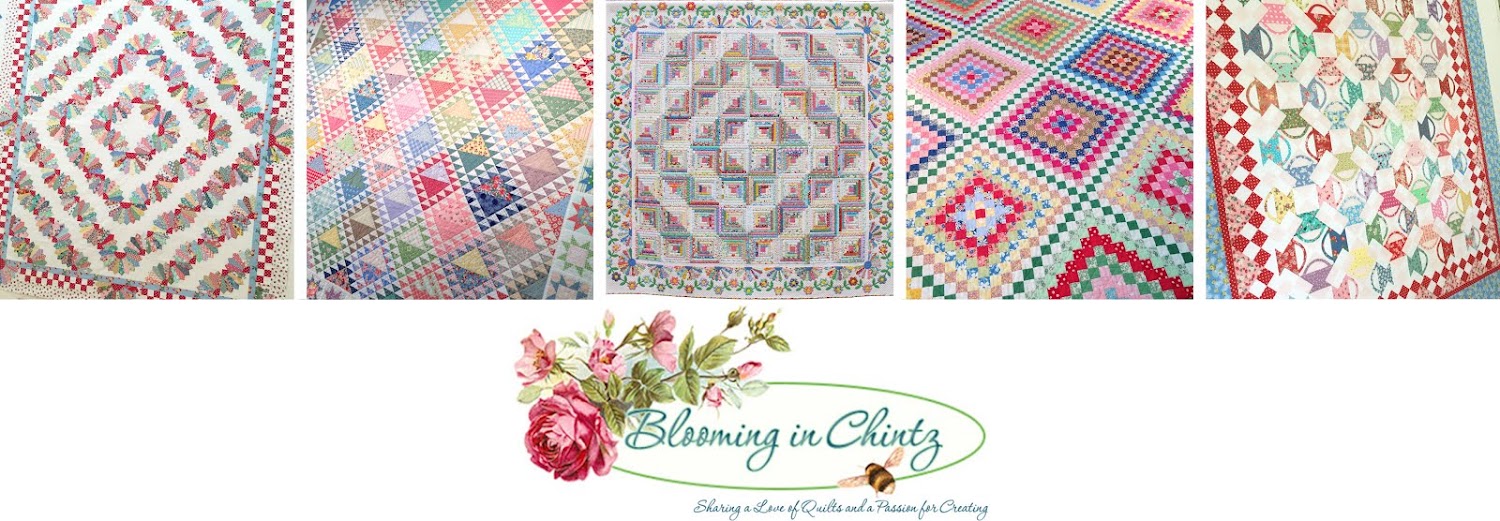



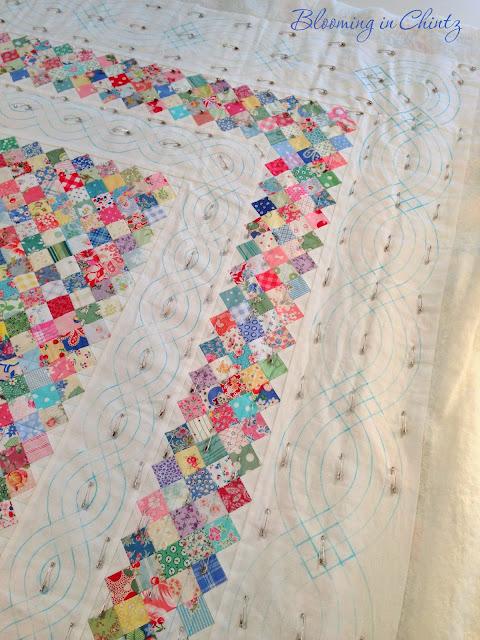













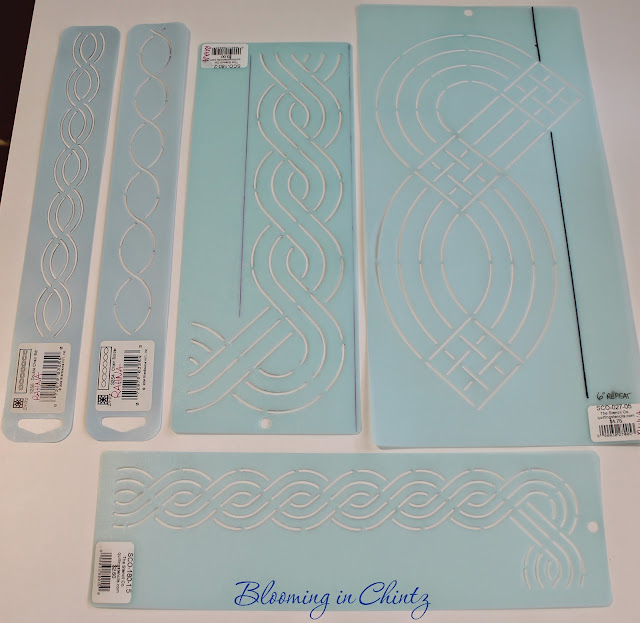
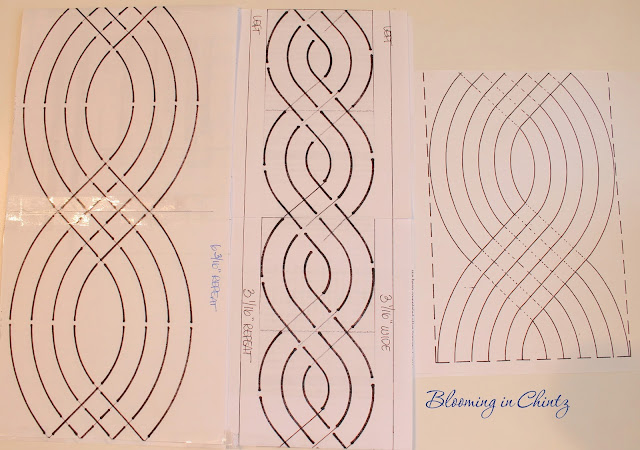


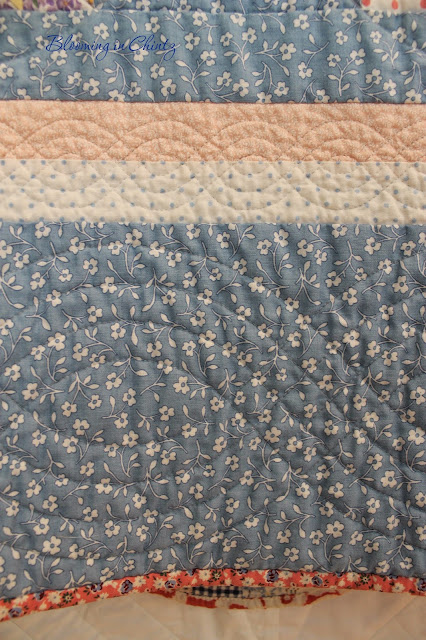


Rahna, great info, thanks so much. I will have to dig thru a pile of stuff, but I am pretty sure I have a couple of cable stencils.Your information about quilting makes me feel better about me using my walking foot for most of my quilting.Thanks.
ReplyDeleteI'm excited to try this! Great tutorial! Thanks a bunch!
ReplyDeleteSo glad to hear Regan! Show pics when you do!
DeleteI typed a comment and it disappeared so if this is a copy, I apologize. I love, love, love your work! Your quilts are so beautiful. I have a quilt that I need to finish with the quilting and binding but I don't know how to finish it. If I sent you a copy of the quilt, could you give me some recommendations? I appreciate your help.
DeleteThanks so much for sharing your techniques! I LOVE your quilt and the fabric you chose for the back!! Lovely!! I have a quilt that I will try these cables on as I have always loved them!! Cheers, Colette
ReplyDeletePretty quilt. Excellent photos. Great tips. I also love cable stitching. Classic. Thank you for such a detailed post.
ReplyDeleteReally love your forty nine cents quilt! I love postage stamp in generaI! I pretty much do the same when I quilt my quilts! Thanks for sharing! Do you mark before you sandwich you quilt?
ReplyDeletethanks for your step by step - I am a hand quilter who is beginning to do some machine quilting but only like the straight lines - I had thought to start doing some cables too so this is wonderful to see. I do not like the all over swirly look of machine quilting and want my quilts to have an antique look to them. Thanks so much for this information - do you use a 3 or 3.5 stitch length?
ReplyDeleteThis is awesome! Excellent tutorial on the whole process. Love the tip about running the whole quilt through the serger and then washing it. You do very beautiful work!
ReplyDeleteThank you! Great information! ~Angela~
ReplyDeleteThis is such a wonderful tutorial. Thank you so much. I am so in love with your postage stamp quilt too! I am in the process of making one and am going to use the cables in the borders also. In as much as there are a zillion squares I am finding this quilt to be so much fun! No strip piecing as I love the randomness of the squares. Thank you for all the tips!!
ReplyDeleteI also like the more traditional quilting styles. Thanks fro sharing your cables
ReplyDeleteWow! what a detailed and clear tutorial, I am going to Pin this now. Have so far only done straight lines in the ditch. Thank you so much, this is inspiring!
ReplyDeleteThe quilting is amazing. I love the classic traditional look of it. The quilts are beautiful!
ReplyDeleteWhat a great tutorial - thanks so much! I do love this quilt too - the borders are perfect.
ReplyDeleteDo you feel a clear sewing table surround is necessary for machine quilting?
ReplyDeleteThank you for the tutorial. What a great job you did quilting your quilt. I Love the cabling. I will have to try it one day. Thanks!
ReplyDeleteFabulous tutorial, thanks very much for sharing.
ReplyDeleteThanks so much for posting this. I feel quite inspired to tackle some quilting now!
ReplyDeletec'est magnifique un vrai chef d'oeuvre bravo bisous
ReplyDeleteThis comment has been removed by the author.
ReplyDeleteVery pretty quilt. I love it.
ReplyDeleteThank you for the detailed tutorial which will help me build up my confidence to try, try, try and try some more.
Grazie, è bellissimo!
ReplyDeleteGrazie, è bellissimo!
ReplyDeleteGreat tutorial. i love the cables. Is there a trick to get them to fit?
ReplyDeleteGreat information! I will be digging out my old stencils!
ReplyDeleteWow, your work is lovely!
ReplyDeleteThank you so much for taking the time to write such a wonderful tutorial. I have a quilt that I am ready to finish and this is perfect for the orders. I appreciate this greatly!
ReplyDeleteInspirational! Thank you for the clear instructions - especially for a new quilter like me. Will save all my scraps and try the cable border next.
ReplyDeletelove this quilt and you gave me back my confidence, will try this out! Bought the stencils and made the quilt so tonight is the night! TV is on as back ground noise as I don't like sewing in the quiet so I shifted m sewing table and ironing board into the sitting room where I can sew to my hearts content! Thank you for the tutorial, best I have seen so far!
ReplyDeleteMerci beaucoup d'avoir posté ce Tutoriel fabuleux, Je suis excité d'essayer un jour , encore milles merci
ReplyDeleteI tried fm quilting, my machine is not cut out for it at all. I do believe I can do this. It sounds doable thank you for sharing.
ReplyDeleteI have only one question. What size stitch do you use 2 or 3? For some reason I can't FM quilt, it's either me or my machine. This gives me confidence to try this. Thank you for sharing!
ReplyDeletethanks so much for taking the time to explain how to do this. i have tried many times and you make it look so easy. maybe i can try again. have a great day
ReplyDeleteI have a 6" outer border that I would like to quilt with a cable. It is already pin basted, so I can't mark with a paper pattern from the back. The fabric is a black print. How do you recommend fitting a cable design so the corners come out nice, and all the same?
ReplyDeleteI have a 6" outer border that I would like to quilt with a cable. It is already pin basted, so I can't mark with a paper pattern from the back. The fabric is a black print. How do you recommend fitting a cable design so the corners come out nice, and all the same?
ReplyDeleteDo you think it is possible to do this technique across the width of a quilt? Stacking the cable rows one upon another? No turning of corners but I am wondering if the manipulation of the quilt would be too much to handle. I'm thinking twin sized quilt. Thanks!
ReplyDeleteVery Inspiring to this quilter who only stitches in the ditch! I think I will start with a baby quilt first,as you said afraid to ruin a top I've worked hard one. Love antique quilts and am going to do a civil war one. Would this cable go with that time frame?
ReplyDeleteYour sewing is beautiful! Thank you so much for the detailed instructions, pictures and inspiration! Anna Herring, Rockport, TX
ReplyDeleteYou can purchase pre-lined paper stencils that have adhesive strips on each side to hold it flat at bordersmadeeasy.com. I found that very helpful in the beginning. They have so many designs, many widths,and are easy to follow. The only complaint I have is they are, in my opinion, expensive.
ReplyDeleteCan't wait to try this. Currently working on my 4th quilt. Excited for the NEXT ONE!!!
ReplyDeleteIt is May 1,2022 and I still love how you quilt. I have never tried anything like this at all--Thank you Wendy Dillon -Pinterest
ReplyDelete